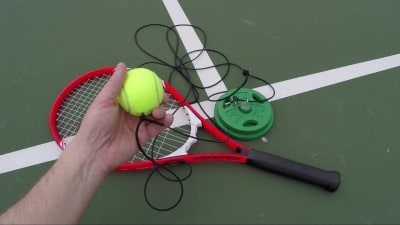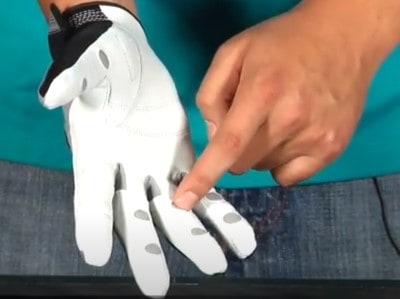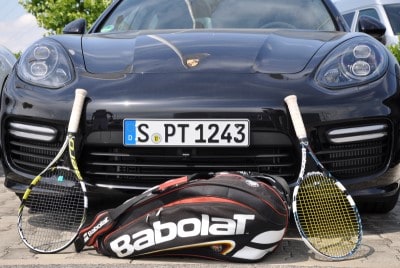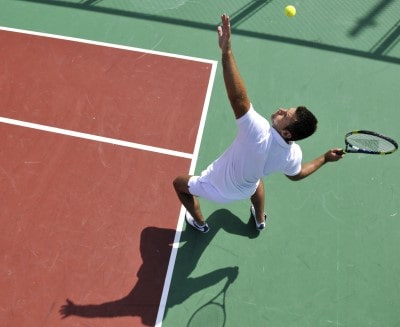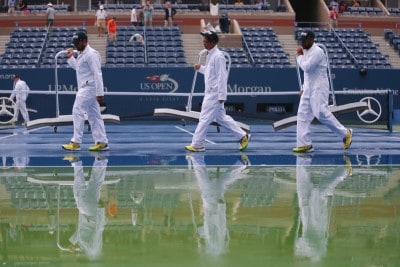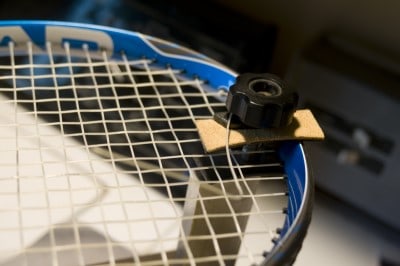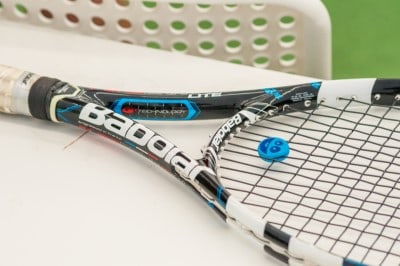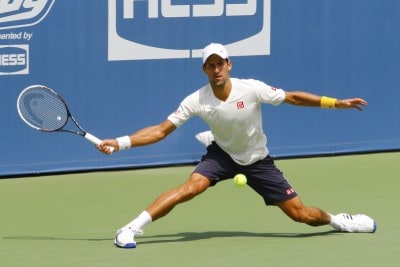Winter always seems like the longest season of the year, especially if you are a tennis player. It’s easy to get rusty in the months of cold weather, sometimes making you feel as though you have started developing your skills all over again! So, how do you keep your skills sharp and remain in top physical condition through the harsh temperatures of winter?
How do you practice tennis during the winter? There are many indoor options for keeping your game strong:
- Join a tennis club
- Practice drills for small, indoor spaces
- Keep up your tennis lessons
- Keep moving
- Outdoor play: Warm up, stay hydrated, adjust clothes and gear, and adapt your style
- Book court time in advance
We’ve put together a guide to provide some tips on staying pro sharp despite the season. From indoor options to safe sub-zero outdoor practices, we’ve got a solution for every player. We’ve even got ideas for how to find a partner and other games you can partake in to keep your skills sharp!
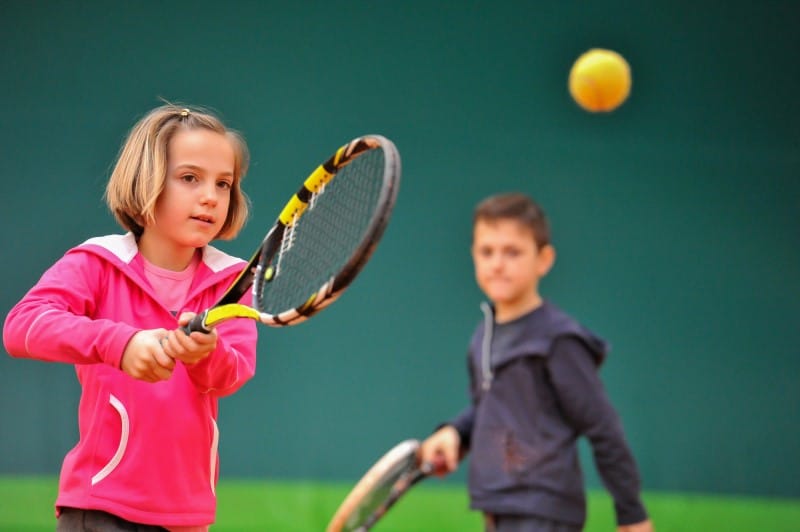
Indoor Options for Keeping Your Game Strong
Believe it or not, there are quite a few options available to perfect your tennis game without having to brave the cold. If going out into freezing cold temperatures isn’t your style, check out some of these options.
Joining a Tennis Club
Joining a tennis club will give you access to a tennis court without having to freeze your tennis socks off. Tennis clubs offer many amenities, typically including workout facilities. Check out pricing at local clubs in your area and start asking around about options before fall ends
You’ll find the pricing varies from club to club based on the individual offerings. Some will require an hourly fee for the use of courts in addition to a monthly membership, while others feature a flat monthly fee.
Inquire about non-member court time as well, despite the higher upfront costs, it’s likely you’ll be saving money in the long run if you don’t plan on utilizing your membership year-round. If cost is a major factor, ask around to see if any of your tennis buddies have guest passes and go together. Not only is that cost-free, but it also provides a partner!
Drills for Inside Small Spaces
You may not realize it, but there are quite a few things you can do to practice inside of your home. Shadow strokes are a great way to perfect your stroke indoors. The best thing about them is they require only a racket and a few square feet of space.
Shadow strokes are great for improving muscle memory and keeping the fluidity of your swing intact. Just do several reps of each type of stroke, including your server. It’s even more helpful if they can be done in front of a mirror. That way you can monitor and perfect your form as well. You can find an extensive guide to shadow strokes here.
There are also a bunch of other exercises that can be done to develop your coordination, all while improving your strength and stamina. Jumping rope is a great way to get some cardio in while working on coordination. Create a personal workout, including core building routines, and not only will you start to see immediate results, but you’ll keep that excess winter weight off as well!
Tennis Lessons
Winter is a great time to work on fine-tuning your tennis skills. Look online to find a good instructor who provides one-on-one instruction. They’ll be able to evaluate and identify issues in your swing or serve. A good instructor will also be able to provide you some strategies to play on your strengths to give you a competitive edge on the court.
Again, it’s best to start this search months before you need an instructor. This is the best way to ensure your top-choice is available.
There are a couple of things you should look for in your search for an instructor:
- Is your instructor certified by the USPTA? The USPTA, or United States Professional Tennis Association, is an organization that offers certification and professional development for professional tennis teachers and tennis coaches. With over 13,500 members, USPTA provides a comprehensive list of qualified instructors. For more information on the USPTA, you can visit their website here.
- Is the instructor certified by the PTR? Another organization regulating tennis instructors is the PTR or Professional Tennis Registry. The PTR is the leading global organization for tennis teachers and coaches. With more than 15,700 members in 125 countries, the PTR has a major commitment to education. They offer five different pathways to certification, each representing the age group coaches specialize in. For more information on the PTR, you can visit their website here.
- What is the instructor’s NTRP rating? An NTRP (National Tennis Rating Program) rating is a great tool to gauge the quality of your instructor. An NTPR rating is a numerical indicator of tennis-playing ability.
The rating system consists of scores from 1.5 (beginner) to 7.0 (touring pro), aligning with a set of general characteristics that break down the skills and abilities of each level in 0.5 increments. A question and answer guide relating to the rating system can be found on the USTA website. Your instructor should have a rating of at least 4.5 or higher.
Keep Moving
The most important part of your practice routine will be to keep up your personal momentum. Newton’s first law of motion comes into play here: “an object in motion tends to stay in motion.” It’s much harder to get going after a complete stop, so maintaining a strong practice routine keeps the rhythm of your game going strong all winter through.
Practicing Outdoors
For those of you brave enough to continue your game outdoors – we commend your dedication and bravery. Although it would seem there isn’t much to do but bundle up, there are a few very important things to consider making sure you are exercising best practices in your outdoor activity.
Warming up
No physical exercise routine is complete without a good warm-up. This allows your body time to limber up and prepare for the physical stress that a workout can cause your body. Although you may be accustomed to a regular warm-up routine, a few things need to be considered to colder weather activity.
It takes a little bit longer to loosen up your muscles in colder weather. While normal warm-up routines usually consist of 2 or 3 minutes of vigorous stretching, a cold-weather routine requires more for optimal muscle performance. You should be giving your body a good 10 minutes or more to prepare for activity. You can find a good routine for warm-up in this video.
Maintaining Proper Hydration
Sometimes hydration is overlooked in the winter months. It’s just as important to stay hydrated as it is in the summer, even though you don’t feel as thirsty. Drinking plenty of water before going out is helpful. There are also water bottles that provide an extra layer of insulation to ensure that your water will not freeze on the court. Read more about water bottles here.
Suiting Up
In cold weather, your normal tennis attire just isn’t going to cut it. There’s not much of a point to winter play if you suffer from frostbite or hypothermia. There are several things to consider in keeping warm but maintaining mobility.
- Sunglasses – There’s a bit of a debate when it comes to wearing sunglasses on the tennis court. They can slide around on your face, causing a major distraction. It’s also a hindrance when the sun goes behind clouds mid-game, decreasing your vision. However, in winter, an exception must be made.
In the winter, the sun hangs lower in the sky than it does in spring and summer. Due to its lower place on the horizon, the glare produced is much worse than usual. Despite your feelings on sunglasses on the tennis court, an exception should be made in winter. There are several different types of bands you can purchase in order to help keep your glasses in place.
- Protective Winter Clothing – If you don’t take the time to properly dress your body, exercising in the winter months can be very dangerous. Frostbite can occur quickly on exposed skin, and wearing clothing soaked with sweat can cause hypothermia.
It’s important to wear layers, of course. Start with a lightweight moisture-wicking base like those found here. Compression pants help to retain heat and wick away moisture and make for a great base layer for bottoms.
These are best worn under layers of insulating fabrics. Water repellent outer layers will keep any snow or precipitation off your body and make a great heat insulator to work with the other layers of clothing.
Be sure to include gloves – even if they hinder your grip. Exposed fingers are usually the first to succumb to exposure. If you are worried about your grip, you can purchase gloves designed specifically with the winter athlete in mind. Last, but certainly not least, it’s important to wear a hat. Your body loses 50% 0f all body heat from you’re the top of your head. You can find a variety online, in addition to neck warmers and other cold winter sports accessories.
Using the Proper Equipment
Not only do you have to change up your wardrobe during your arctic weather practice, but you need to consider the effects of the cold on your equipment. Some of your equipment simply does not function as well in the colder air.
Softer Racquet Strings – In lower temperatures, the strings on your racquet will become significantly stiffer. Not only will this make the impact had on the ball different, but it makes then ten times more likely to break during usage.
Strings with softer compositions will reduce the need to replace strings due to breakage. You can find strings made of softer materials here. You’ll also find these strings, typically made of multi-filament or natural gut, will perform much better than the standard strings.
Adjust Your Playing Style
Frigid weather has some really weird effects on tennis balls. Rubber hardens in low temperatures, and the air pressure inside of the balls drops as well. These elements give the ball a deceiving much softer feel in your hand but will become much harder upon impact. This makes for a very different kind of tennis playing when the ball has far less bounce.
The combination of the reduced bounce in the ball and the reduction of elasticity in the racquet make it necessary to alter your game a little. You will have to shift your aim to be a bit deeper and hit much harder to get the ball over the net.
You’ll quickly find that top spins will lose their effectiveness. However, drop shots, slices, and flat serves become far more effective. Winter requires much more movement on the court than in summer. Players will have to travel deeper into the court to catch low balls.
For some tips on winter weather strokes as well as other tips, check out the video below made by tennis Pro Ben Wolfe. Playing tennis in winter is practically like playing a whole new sport!
Book Court Time in Advance
Lots of your local clubs take all of their nets down in the winter, which means you may have to get a bit more creative in finding a place to play. Because of this, you’ll have to make sure you are booking your court time in advance to ensure availability.
In order to deflect costs, you may want to organize a few games with some other players as well. Work out a schedule early on to reserve a time. Without proper reservations, chances are you may find yourself disappointed.
Having a Hard Time Getting Players Together?
Not everyone is easily motivated to venture outdoors in the winter. If you are having difficulty in getting other players together for games, perhaps you could entice them with a few scientifically proven facts to support your cause.
- Improved Coordination – In order to play tennis well, you need to keep expert communication between your eyes, hands, and legs. The more often you play, the better your coordination becomes. As mentioned before, the winter months can cause a loss of your competitive edge.
- Muscle Development – Because the tennis demands lots of movement and a fine-tuning of your personal momentum, it serves to be far more effective of a workout than routines dedicated to strengthening one muscle at a time. Proper muscle tone also improves bone health as well.
- Beat the Winter Blues – Seasonal Affective Disorder is very common during the dark and dreary winter season. Tennis players are known to be more positive and energetic. Studies have shown that the game improves overall mood and emotional health.
- Keep Your Brain Sharp – Just like we talked about in regard to coordination, this game requires you to be alert all the time. This keeps your brain in a constant state of growth and boosts logical thought processes.
- Healthy Cardiovascular Workout – Tennis games, lasting on an average of two hours each, provide a great cardiovascular workout. The constant movement causes your heart to beat faster, burning more fat. This reduces your risk of heart attack and stroke. In fact, regular tennis playing reduces quite a number of untimely deaths. You can check the statistical information here.
Still Having a Hard time Finding Partners?
No matter how old you are or how good you are, tennis is a great way to keep physically fit and make lots of new friends. Don’t let the cold weather deter you from your love of the game.
If you can’t get your fellow players out of the house and moving around, there are still options. You can join groups like this one to match up with other like-minded snowbirds or find active winter leagues.
Other Winter Playing Options
- Platform Tennis, the brainchild of James Cogswell and Fessenden Blanchard in 1928 at the Meadow Tennis Club in Scarsdale, New York. These two avid players were desperate to find a way to keep their play going despite the environment.
Although it was originally created in an effort to find means to play the game on land otherwise unsuitable for tennis play, they also found that it was incredibly useful for winter play. Platform Tennis is played in a smaller court surrounded by a fence on a specially designed platform. These platforms allow for heaters to be installed under them, keeping the surface playable despite the weather as well as generate heat for the players.
- Ping Pong – Yes, Ping Pong. Believe it or not, Ping Pong requires many of the same skills as tennis. Players need to be alert and possess excellent hand-eye coordination. Although there isn’t quite as much full-court movement, it will certainly serve to keep your skills sharp.
- Badminton – In Badminton, the use of a tennis ball is substituted with a shuttlecock. With the usage of lighter racquets and the lightweight shuttlecock, Badminton is much better suited for playing in a garage or other large indoor open areas. Read our full article on Tennis Vs. Badminton.
- Racquetball – Racquetball requires no net or large court. All you need is a racquetball racquet and a rubber ball. Racquetball courts can be found in many gyms across the world. This game is designed to either play with a partner or alone, so a lack of a partner is no problem at all! The ball is hit against a wall with the racquet and hit again on the return. (This is how you are able to play on your own) The strokes are very similar to the strokes in tennis.
Looking for more options? Check out this reference to discover more games.
Don’t Let a Little Cold Weather Stand in Your Way
With all the options and hints we’ve gone through today, there’s no reason to let the colder months of the year keep you from your game. A little bit of planning and equipment will go a long way in keeping you in tip-top condition and giving you a competitive edge. Just think, when you hit the courts next spring, you’ll be way ahead of your competition!

